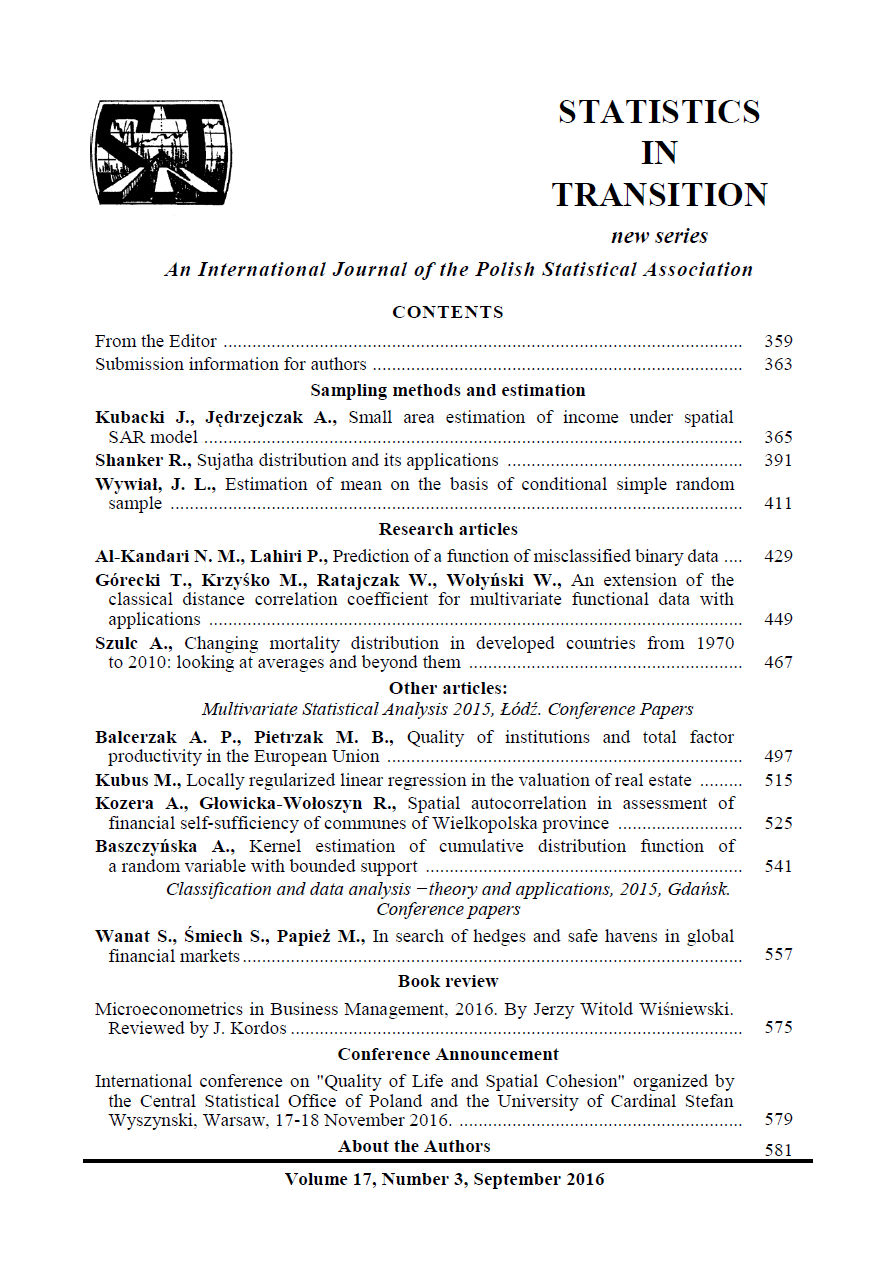ARTICLE
ABSTRACT
The paper presents the method of hierarchical Bayes (HB) estimation under small area models with spatially correlated random effects and a spatial structure implied by the Simultaneous Autoregressive (SAR) process. The idea was to improve the spatial EBLUP by incorporating the HB approach into the estimation algorithm. The computation procedure applied in the paper uses the concept of sampling from a posterior distribution under generalized linear mixed models implemented in WinBUGS software and adapts the idea of parameter estimation for small areas by means of the HB method in the case of known model hyperparameters. The illustration of the approach mentioned above was based on a real-world example concerning household income data. The precision of the direct estimators was determined using own three-stage procedure which employs Balanced Repeated Replication, bootstrap and Generalized Variance Function. Additional simulations were conducted to show the influence of the spatial autoregression coefficient on the estimation error reduction. The computations performed by ‘sae’ package for R project and a special procedure for WinBUGS reveal that the method provides reliable estimates of small area means. For high spatial correlation between domains, noticeable MSE reduction was observed, which seems more evident for HB-SAR method as compared with the traditional spatial EBLUP. In our opinion, the Gibbs sampler, revealing the simultaneous nature of processes, especially for random effects, can be a good starting point for the simulations based on stochastic SAR processes.
KEYWORDS
small area estimation (SAE), SAR model, hierarchical Bayes estimation, spatial empirical best linear unbiased predictor.
REFERENCES
BIVAND, R., LEWIN-KOH, N., (2013). maptools: Tools for reading and handling spatial objects. R package version 0.8-25,http://CRAN.R-project.org/package=maptools.
BIVAND, R., PIRAS, G., (2015). Comparing Implementations of Estimation Methods for Spatial Econometrics, Journal of Statistical Software, 63, No. 18, pp. 1–36, http://www.jstatsoft.org/v63/i18/.
CRESSIE, N. A .C., (1991). Small-area prediction of undercount using the general linear model, Proceedings of Statistic Symposium 90: Measurement and Improvement of Data Quality, Ottawa, Statistics Canada, pp. 93–105.
GHARDE, Y., RAI, A., JAGGI, S., (2013). Bayesian Prediction in Spatial Small Area Models, Journal of the Indian Society of Agricultural Statistics, 67, pp. 355–362.
GILKS, W. R., BEST, N. G., TAN, K. K. C., (1995). Adaptive Rejection Metropolis Sampling within Gibbs Sampling, Applied Statistics, 4, pp. 455–472.
GOMEZ-RUBIO, V., (2008). Tutorial: Small Area Estimation with R The R User Conference 2008, August 12-14, Technische Universitat Dortmund, Germany.
GRIFFITH, D. A., PAELINCK, J. H. P., (2011). Non-standard Spatial Statistics and Spatial Econometrics, Advances in Geographic Information Science, Springer Berlin Heidelberg.
KUBACKI, J. (2012). Estimation of parameters for small areas using hierarchical Bayes method in the case of known model hyperparameters, Statistics in Transition-new series, 13, No. 2, pp. 261–278.
KUBACKI, J., JĘDRZEJCZAK, A., (2012). The Comparison of Generalized Variance Function with Other Methods of Precision Estimation for Polish Household Budget Survey, Studia Ekonomiczne, 120, pp. 58–69.
MOLINA, I., MARHUENDA, Y., (2013). SAE: Small Area Estimation, R package version 1.0-2 http://CRAN.R-project.org/package=sae.
MOLINA, I., MARHUENDA, Y., (2015). R package sae: Methodology - sae package vignette:https://cran.r-project.org/web/packages/sae/vignettes/sae_methodology.pdf
DE OLIVEIRA, V., JOON, JIN SONG, (2008). Bayesian Analysis of Simultaneous Autoregressive Models, Sankhya, 70-B, No. 2, pp. 323–350.
PETRUCCI, A., SALVATI, N., (2006). Small Area Estimation for Spatial Correlation in Watershed Erosion Assessment, Journal of Agricultural, Biological & Environmental Statistics, 11, No. 2, pp. 169–182,http://dx.doi.org/10.1198/108571106x110531.
PRATESI, M., SALVATI, N., (2004). Spatial EBLUP in agricultural survey. An application based on census data, Working paper no. 256, Universitá di Pisa, Dipartimento di statistica e matematica applicata all'economia.
PRATESI, M., SALVATI, N., (2005). Small Area Estimation: The EBLUP Estimator with Autoregressive Random Area Effects, Working paper n. 261 Pubblicazioni del Dipartimento di statistica e matematica applicata all'economia.
PRATESI, M., SALVATI, N., (2008). Small area estimation: the EBLUP estimator based on spatially correlated random area effects, Statistical Methods and Applications, 17, No. 1, pp. 113–141, http://dx.doi.org/10.1007/s10260-007-0061-9.
RAO, J. N. K., (2003). Small Area Estimation, John Wiley & Sons,http://books.google.pl/books?id=f8NY6M-5EEwC.
SAEI, A., CHAMBERS, R., (2003). Small Area Estimation Under Linear and Generalized Linear Mixed Models With Time and Area Effects, M03/15, Southampton Statistical Sciences Research Institute, http://eprints.soton.ac.uk/8165/.
SALVATI, N., GIUSTI, C., MARCHETTI, S., PRATESI, M., TZAVIDIS, N., MOLINA, I., MORALES, D., ESTEBAN, M. D., SANTAMARIA, L., MARHUENDA, Y., PEREZ, A., PAGLIARELLA, M., CHAMBERS, R., RAO, J. N. K., FERRETTI, C., (2011). Software on small area estimation, Deliverable 22, http://sample-project.eu/images/stories/deliverables/d22.pdf.
SINGH, B. B., SHUKLA, G. K., KUNDU, D., (2005). Spatio-Temporal Models in Small Area Estimation, Survey Methodology, 31, No. 2, pp. 183–195.
SPIEGELHALTER, D. J., THOMAS, A., BEST, N., LUNN, D., (2003).WinBUGS User Manual, Version 1.4, http://www.mrc-bsu.cam.ac.uk/wp content/uploads/manual14.pdf.
STURTZ, S., LIGGES, U., GELMAN, A., (2005). R2WinBUGS: A Package for Running WinBUGS from R, Journal of Statistical Software, 12, No. 3.
VOGT, M., (2010). Bayesian Spatial Modeling: Propriety and Applications to Small Area Estimation with Focus on the German Census 2011, Universitat Trier
